CIS8011 Digital Innovation Report: Voice Recognition for CityRail
VerifiedAdded on 2023/06/07
|22
|4896
|454
Report
AI Summary
This report provides a comprehensive analysis of digital innovation, focusing on the implementation of voice recognition technology within the context of CityRail, a tourism company. It explores both short-term and long-term strategies for launching a Minimum Viable Product (MVP), including market validation, focus groups, and user acceptance testing. The report delves into the mission, vision, goals, objectives, and tactics necessary for successful implementation, along with a detailed cost-benefit analysis. Furthermore, it outlines the product/services roadmap, addresses potential issues with voice recognition, and provides recommendations for future development. The report also includes a discussion of the business model canvas and customer journey analysis, offering insights into attracting and retaining customers. The document includes a discussion on both Agile and Waterfall methodologies for software development and highlights the importance of iterative approaches to product improvement. It also presents a cost-benefit analysis of the proposed system and concludes with recommendations for the future.
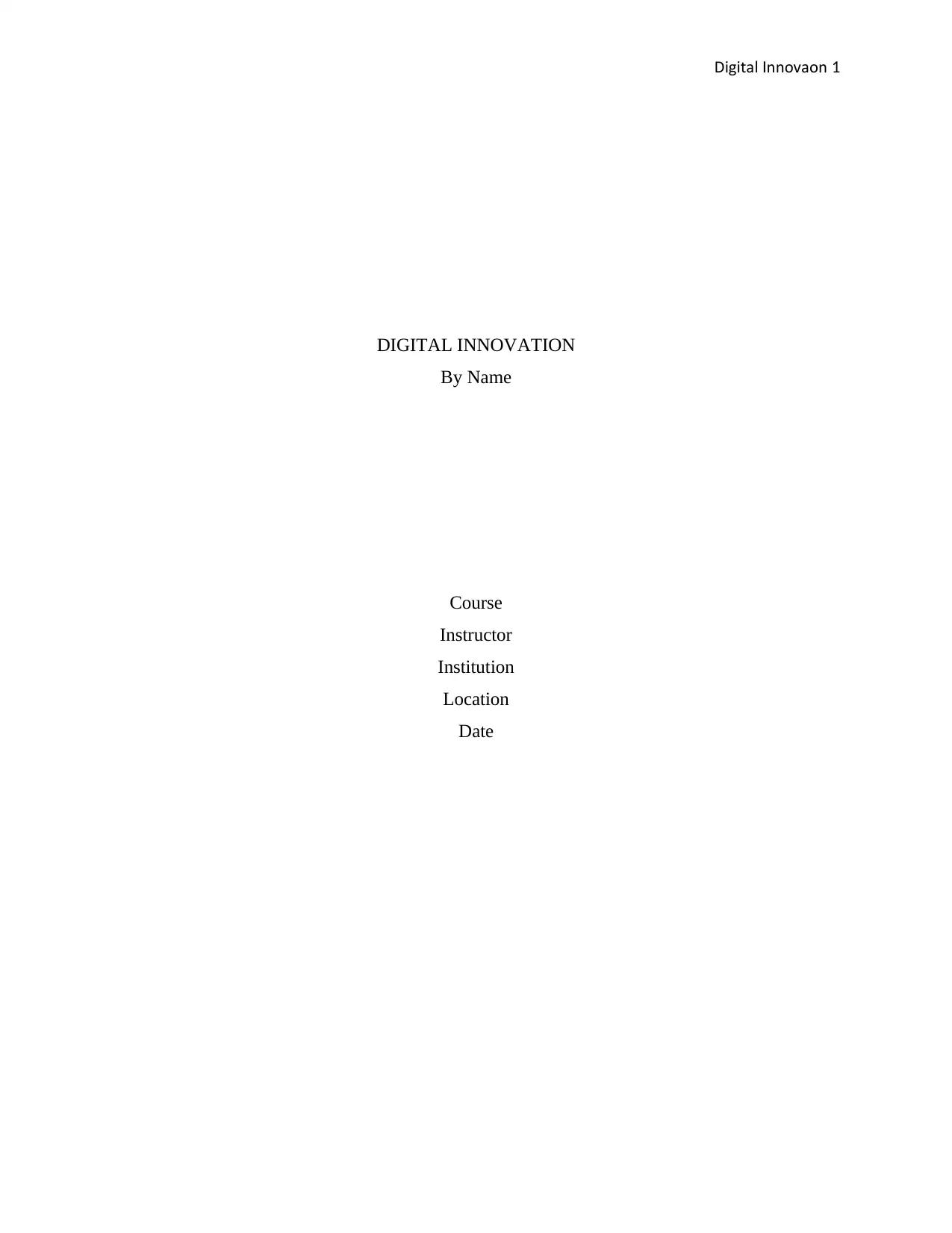
Digital nnovationI 1
DIGITAL INNOVATION
By Name
Course
Instructor
Institution
Location
Date
DIGITAL INNOVATION
By Name
Course
Instructor
Institution
Location
Date
Paraphrase This Document
Need a fresh take? Get an instant paraphrase of this document with our AI Paraphraser
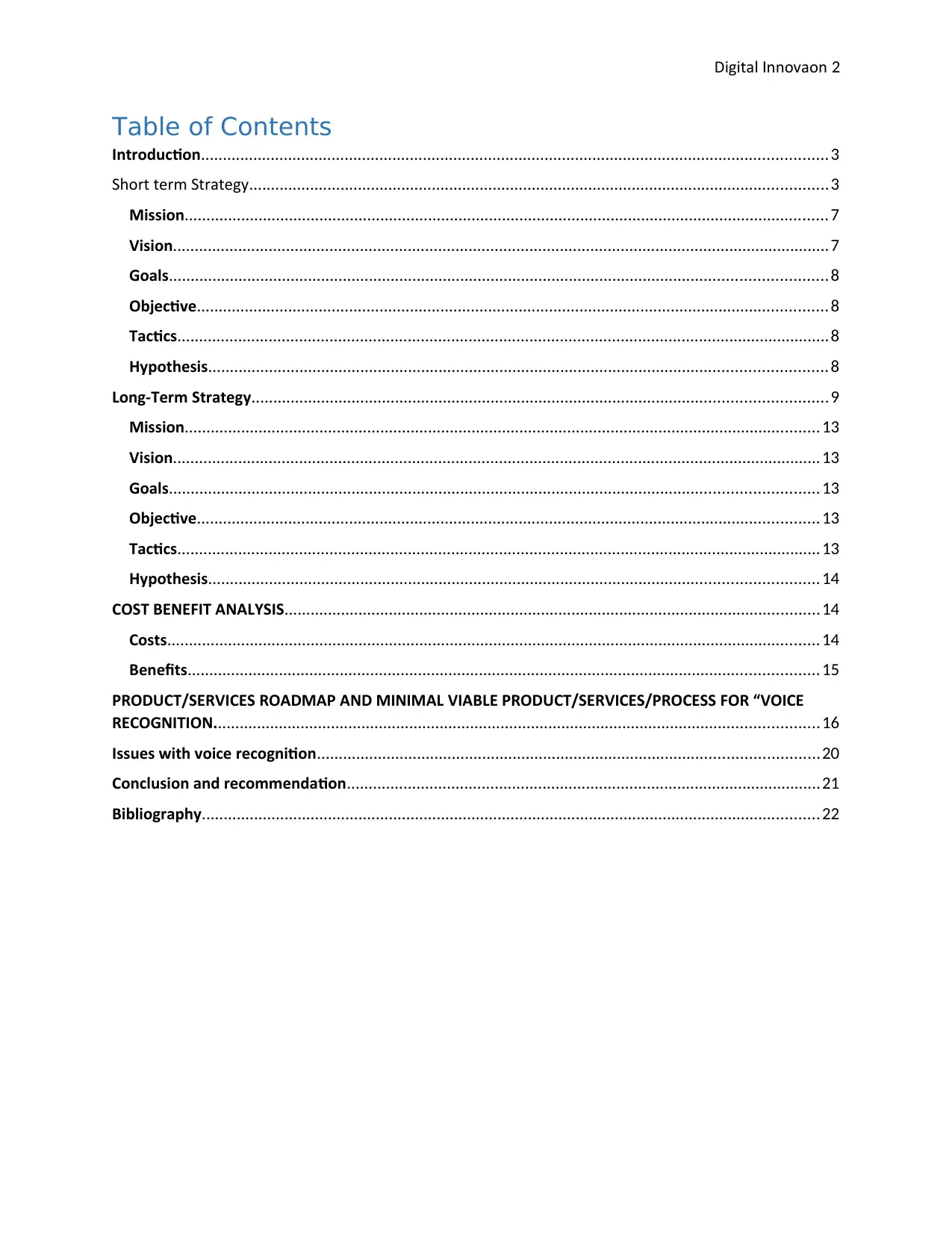
Digital nnovationI 2
Table of Contents
Introduction................................................................................................................................................3
Short term Strategy.....................................................................................................................................3
Mission....................................................................................................................................................7
Vision.......................................................................................................................................................7
Goals.......................................................................................................................................................8
Objective.................................................................................................................................................8
Tactics......................................................................................................................................................8
Hypothesis..............................................................................................................................................8
Long-Term Strategy....................................................................................................................................9
Mission..................................................................................................................................................13
Vision.....................................................................................................................................................13
Goals..................................................................................................................................................... 13
Objective...............................................................................................................................................13
Tactics....................................................................................................................................................13
Hypothesis............................................................................................................................................14
COST BENEFIT ANALYSIS...........................................................................................................................14
Costs...................................................................................................................................................... 14
Benefits.................................................................................................................................................15
PRODUCT/SERVICES ROADMAP AND MINIMAL VIABLE PRODUCT/SERVICES/PROCESS FOR “VOICE
RECOGNITION...........................................................................................................................................16
Issues with voice recognition...................................................................................................................20
Conclusion and recommendation.............................................................................................................21
Bibliography..............................................................................................................................................22
Table of Contents
Introduction................................................................................................................................................3
Short term Strategy.....................................................................................................................................3
Mission....................................................................................................................................................7
Vision.......................................................................................................................................................7
Goals.......................................................................................................................................................8
Objective.................................................................................................................................................8
Tactics......................................................................................................................................................8
Hypothesis..............................................................................................................................................8
Long-Term Strategy....................................................................................................................................9
Mission..................................................................................................................................................13
Vision.....................................................................................................................................................13
Goals..................................................................................................................................................... 13
Objective...............................................................................................................................................13
Tactics....................................................................................................................................................13
Hypothesis............................................................................................................................................14
COST BENEFIT ANALYSIS...........................................................................................................................14
Costs...................................................................................................................................................... 14
Benefits.................................................................................................................................................15
PRODUCT/SERVICES ROADMAP AND MINIMAL VIABLE PRODUCT/SERVICES/PROCESS FOR “VOICE
RECOGNITION...........................................................................................................................................16
Issues with voice recognition...................................................................................................................20
Conclusion and recommendation.............................................................................................................21
Bibliography..............................................................................................................................................22
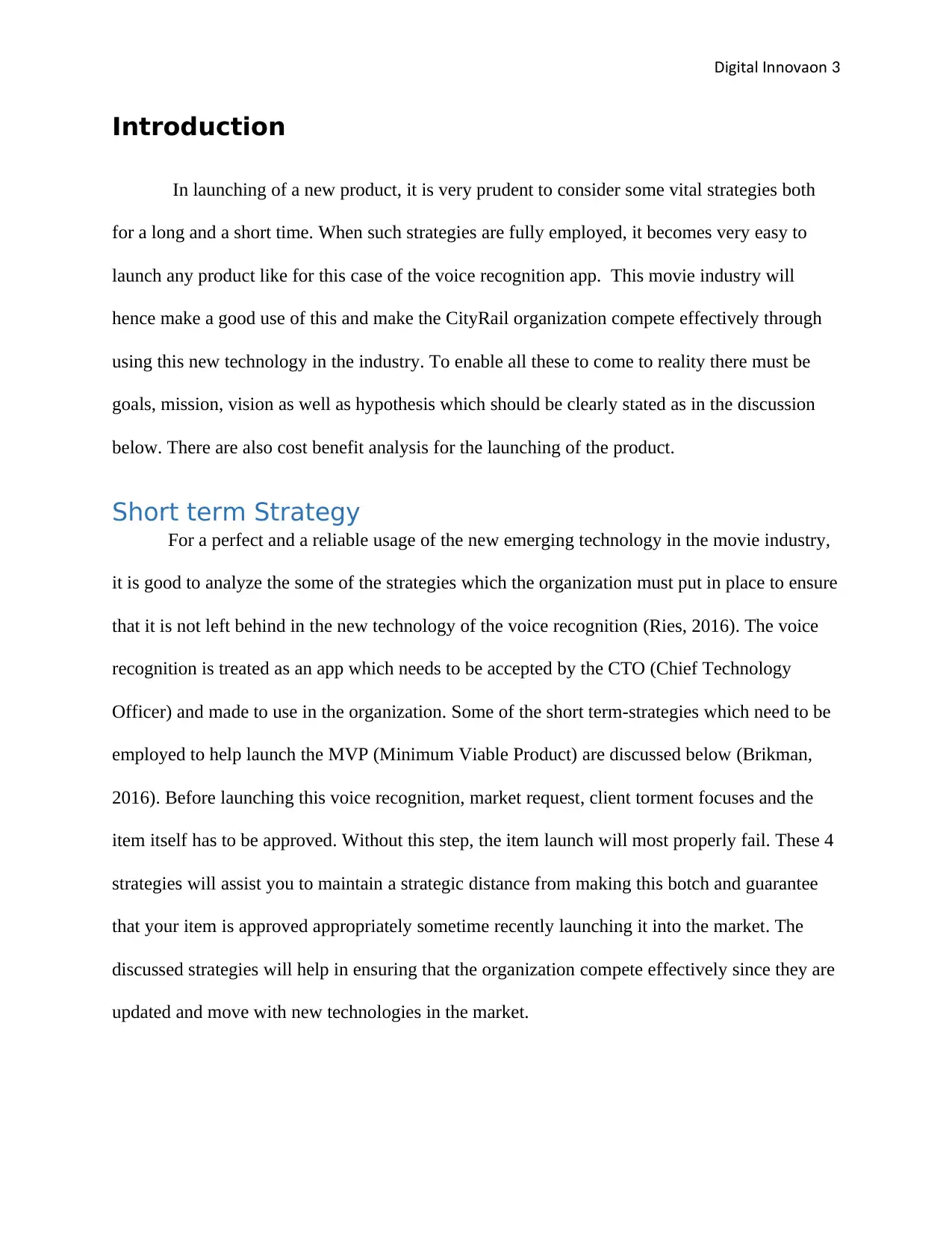
Digital nnovationI 3
Introduction
In launching of a new product, it is very prudent to consider some vital strategies both
for a long and a short time. When such strategies are fully employed, it becomes very easy to
launch any product like for this case of the voice recognition app. This movie industry will
hence make a good use of this and make the CityRail organization compete effectively through
using this new technology in the industry. To enable all these to come to reality there must be
goals, mission, vision as well as hypothesis which should be clearly stated as in the discussion
below. There are also cost benefit analysis for the launching of the product.
Short term Strategy
For a perfect and a reliable usage of the new emerging technology in the movie industry,
it is good to analyze the some of the strategies which the organization must put in place to ensure
that it is not left behind in the new technology of the voice recognition (Ries, 2016). The voice
recognition is treated as an app which needs to be accepted by the CTO (Chief Technology
Officer) and made to use in the organization. Some of the short term-strategies which need to be
employed to help launch the MVP (Minimum Viable Product) are discussed below (Brikman,
2016). Before launching this voice recognition, market request, client torment focuses and the
item itself has to be approved. Without this step, the item launch will most properly fail. These 4
strategies will assist you to maintain a strategic distance from making this botch and guarantee
that your item is approved appropriately sometime recently launching it into the market. The
discussed strategies will help in ensuring that the organization compete effectively since they are
updated and move with new technologies in the market.
Introduction
In launching of a new product, it is very prudent to consider some vital strategies both
for a long and a short time. When such strategies are fully employed, it becomes very easy to
launch any product like for this case of the voice recognition app. This movie industry will
hence make a good use of this and make the CityRail organization compete effectively through
using this new technology in the industry. To enable all these to come to reality there must be
goals, mission, vision as well as hypothesis which should be clearly stated as in the discussion
below. There are also cost benefit analysis for the launching of the product.
Short term Strategy
For a perfect and a reliable usage of the new emerging technology in the movie industry,
it is good to analyze the some of the strategies which the organization must put in place to ensure
that it is not left behind in the new technology of the voice recognition (Ries, 2016). The voice
recognition is treated as an app which needs to be accepted by the CTO (Chief Technology
Officer) and made to use in the organization. Some of the short term-strategies which need to be
employed to help launch the MVP (Minimum Viable Product) are discussed below (Brikman,
2016). Before launching this voice recognition, market request, client torment focuses and the
item itself has to be approved. Without this step, the item launch will most properly fail. These 4
strategies will assist you to maintain a strategic distance from making this botch and guarantee
that your item is approved appropriately sometime recently launching it into the market. The
discussed strategies will help in ensuring that the organization compete effectively since they are
updated and move with new technologies in the market.
⊘ This is a preview!⊘
Do you want full access?
Subscribe today to unlock all pages.

Trusted by 1+ million students worldwide
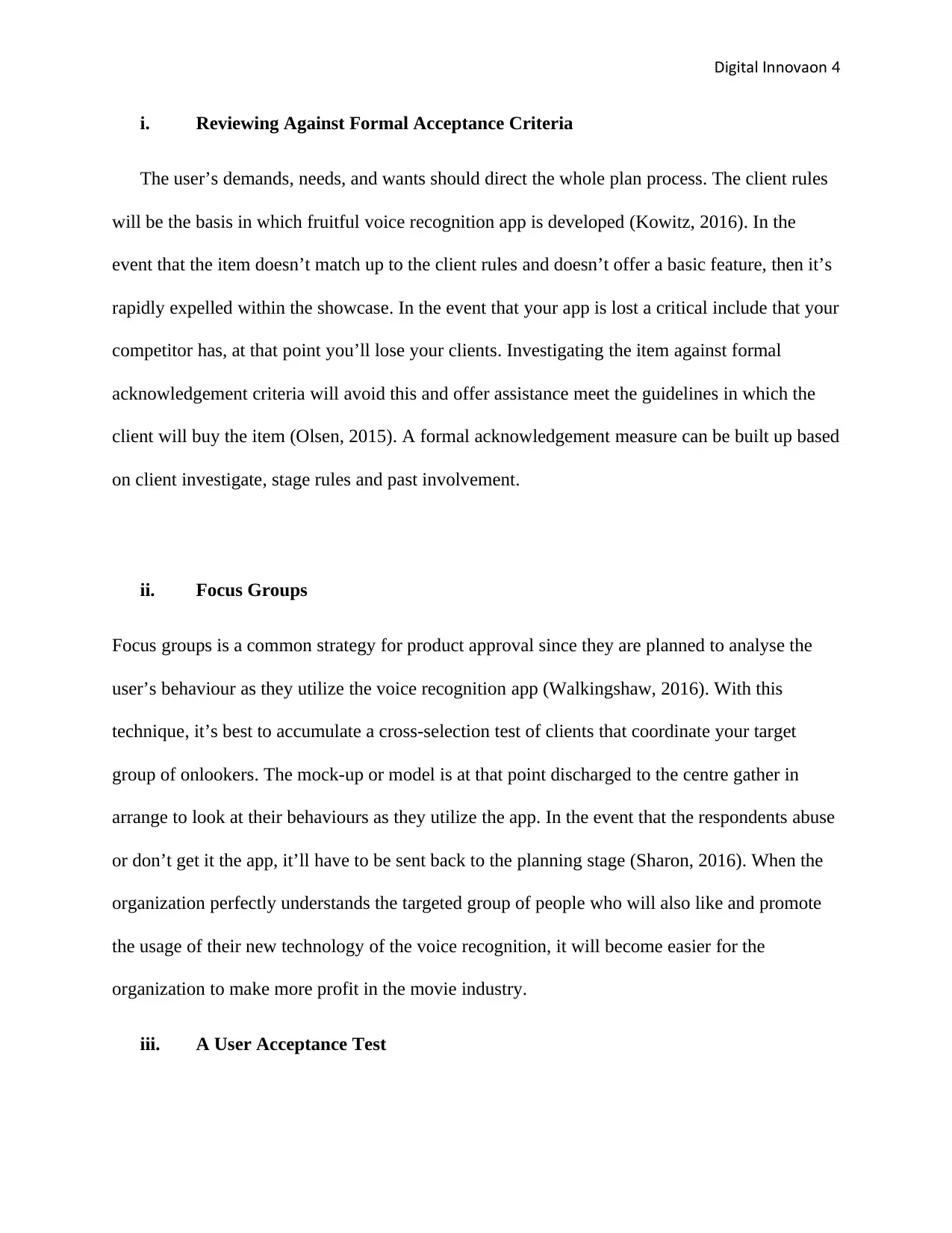
Digital nnovationI 4
i. Reviewing Against Formal Acceptance Criteria
The user’s demands, needs, and wants should direct the whole plan process. The client rules
will be the basis in which fruitful voice recognition app is developed (Kowitz, 2016). In the
event that the item doesn’t match up to the client rules and doesn’t offer a basic feature, then it’s
rapidly expelled within the showcase. In the event that your app is lost a critical include that your
competitor has, at that point you’ll lose your clients. Investigating the item against formal
acknowledgement criteria will avoid this and offer assistance meet the guidelines in which the
client will buy the item (Olsen, 2015). A formal acknowledgement measure can be built up based
on client investigate, stage rules and past involvement.
ii. Focus Groups
Focus groups is a common strategy for product approval since they are planned to analyse the
user’s behaviour as they utilize the voice recognition app (Walkingshaw, 2016). With this
technique, it’s best to accumulate a cross-selection test of clients that coordinate your target
group of onlookers. The mock-up or model is at that point discharged to the centre gather in
arrange to look at their behaviours as they utilize the app. In the event that the respondents abuse
or don’t get it the app, it’ll have to be sent back to the planning stage (Sharon, 2016). When the
organization perfectly understands the targeted group of people who will also like and promote
the usage of their new technology of the voice recognition, it will become easier for the
organization to make more profit in the movie industry.
iii. A User Acceptance Test
i. Reviewing Against Formal Acceptance Criteria
The user’s demands, needs, and wants should direct the whole plan process. The client rules
will be the basis in which fruitful voice recognition app is developed (Kowitz, 2016). In the
event that the item doesn’t match up to the client rules and doesn’t offer a basic feature, then it’s
rapidly expelled within the showcase. In the event that your app is lost a critical include that your
competitor has, at that point you’ll lose your clients. Investigating the item against formal
acknowledgement criteria will avoid this and offer assistance meet the guidelines in which the
client will buy the item (Olsen, 2015). A formal acknowledgement measure can be built up based
on client investigate, stage rules and past involvement.
ii. Focus Groups
Focus groups is a common strategy for product approval since they are planned to analyse the
user’s behaviour as they utilize the voice recognition app (Walkingshaw, 2016). With this
technique, it’s best to accumulate a cross-selection test of clients that coordinate your target
group of onlookers. The mock-up or model is at that point discharged to the centre gather in
arrange to look at their behaviours as they utilize the app. In the event that the respondents abuse
or don’t get it the app, it’ll have to be sent back to the planning stage (Sharon, 2016). When the
organization perfectly understands the targeted group of people who will also like and promote
the usage of their new technology of the voice recognition, it will become easier for the
organization to make more profit in the movie industry.
iii. A User Acceptance Test
Paraphrase This Document
Need a fresh take? Get an instant paraphrase of this document with our AI Paraphraser
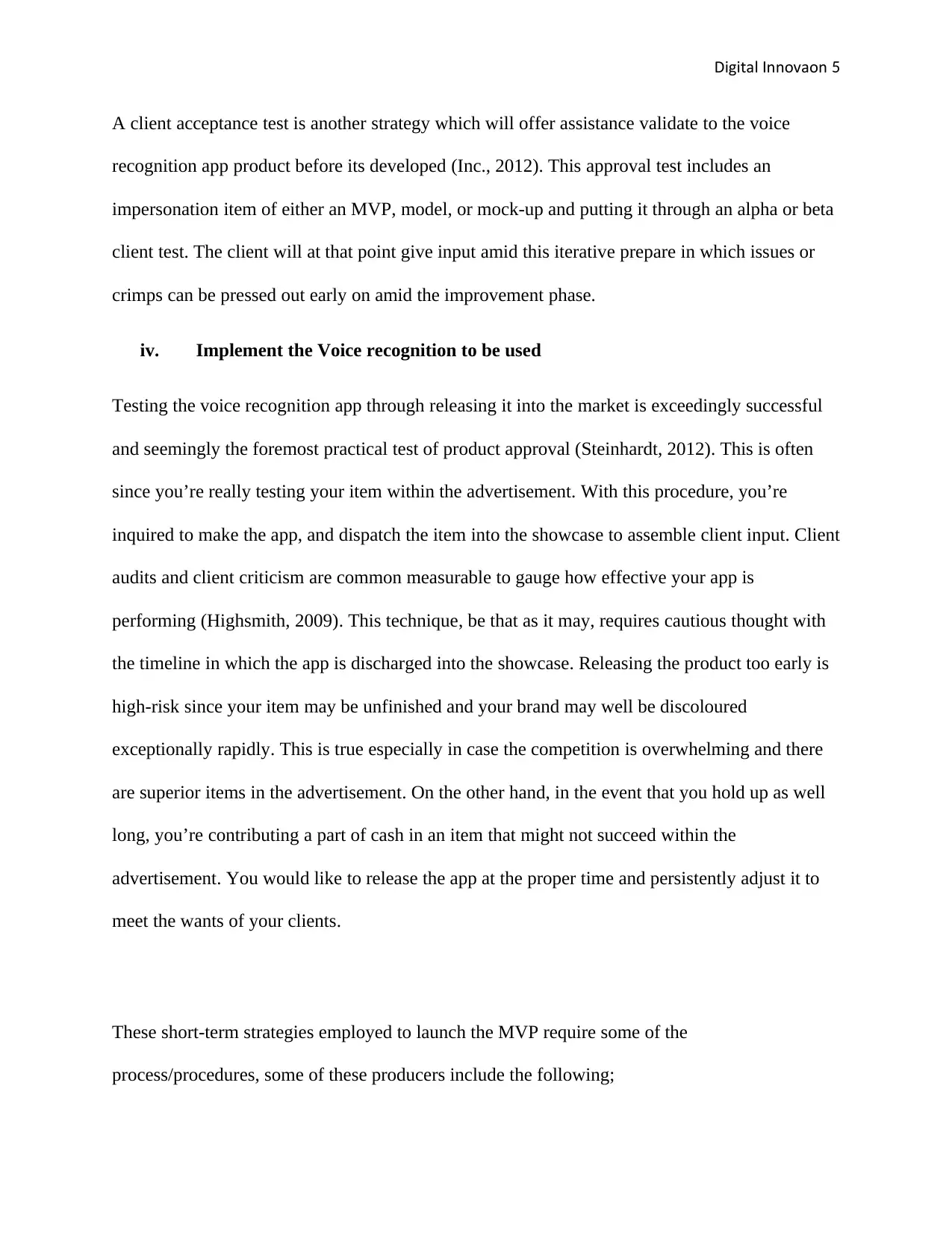
Digital nnovationI 5
A client acceptance test is another strategy which will offer assistance validate to the voice
recognition app product before its developed (Inc., 2012). This approval test includes an
impersonation item of either an MVP, model, or mock-up and putting it through an alpha or beta
client test. The client will at that point give input amid this iterative prepare in which issues or
crimps can be pressed out early on amid the improvement phase.
iv. Implement the Voice recognition to be used
Testing the voice recognition app through releasing it into the market is exceedingly successful
and seemingly the foremost practical test of product approval (Steinhardt, 2012). This is often
since you’re really testing your item within the advertisement. With this procedure, you’re
inquired to make the app, and dispatch the item into the showcase to assemble client input. Client
audits and client criticism are common measurable to gauge how effective your app is
performing (Highsmith, 2009). This technique, be that as it may, requires cautious thought with
the timeline in which the app is discharged into the showcase. Releasing the product too early is
high-risk since your item may be unfinished and your brand may well be discoloured
exceptionally rapidly. This is true especially in case the competition is overwhelming and there
are superior items in the advertisement. On the other hand, in the event that you hold up as well
long, you’re contributing a part of cash in an item that might not succeed within the
advertisement. You would like to release the app at the proper time and persistently adjust it to
meet the wants of your clients.
These short-term strategies employed to launch the MVP require some of the
process/procedures, some of these producers include the following;
A client acceptance test is another strategy which will offer assistance validate to the voice
recognition app product before its developed (Inc., 2012). This approval test includes an
impersonation item of either an MVP, model, or mock-up and putting it through an alpha or beta
client test. The client will at that point give input amid this iterative prepare in which issues or
crimps can be pressed out early on amid the improvement phase.
iv. Implement the Voice recognition to be used
Testing the voice recognition app through releasing it into the market is exceedingly successful
and seemingly the foremost practical test of product approval (Steinhardt, 2012). This is often
since you’re really testing your item within the advertisement. With this procedure, you’re
inquired to make the app, and dispatch the item into the showcase to assemble client input. Client
audits and client criticism are common measurable to gauge how effective your app is
performing (Highsmith, 2009). This technique, be that as it may, requires cautious thought with
the timeline in which the app is discharged into the showcase. Releasing the product too early is
high-risk since your item may be unfinished and your brand may well be discoloured
exceptionally rapidly. This is true especially in case the competition is overwhelming and there
are superior items in the advertisement. On the other hand, in the event that you hold up as well
long, you’re contributing a part of cash in an item that might not succeed within the
advertisement. You would like to release the app at the proper time and persistently adjust it to
meet the wants of your clients.
These short-term strategies employed to launch the MVP require some of the
process/procedures, some of these producers include the following;
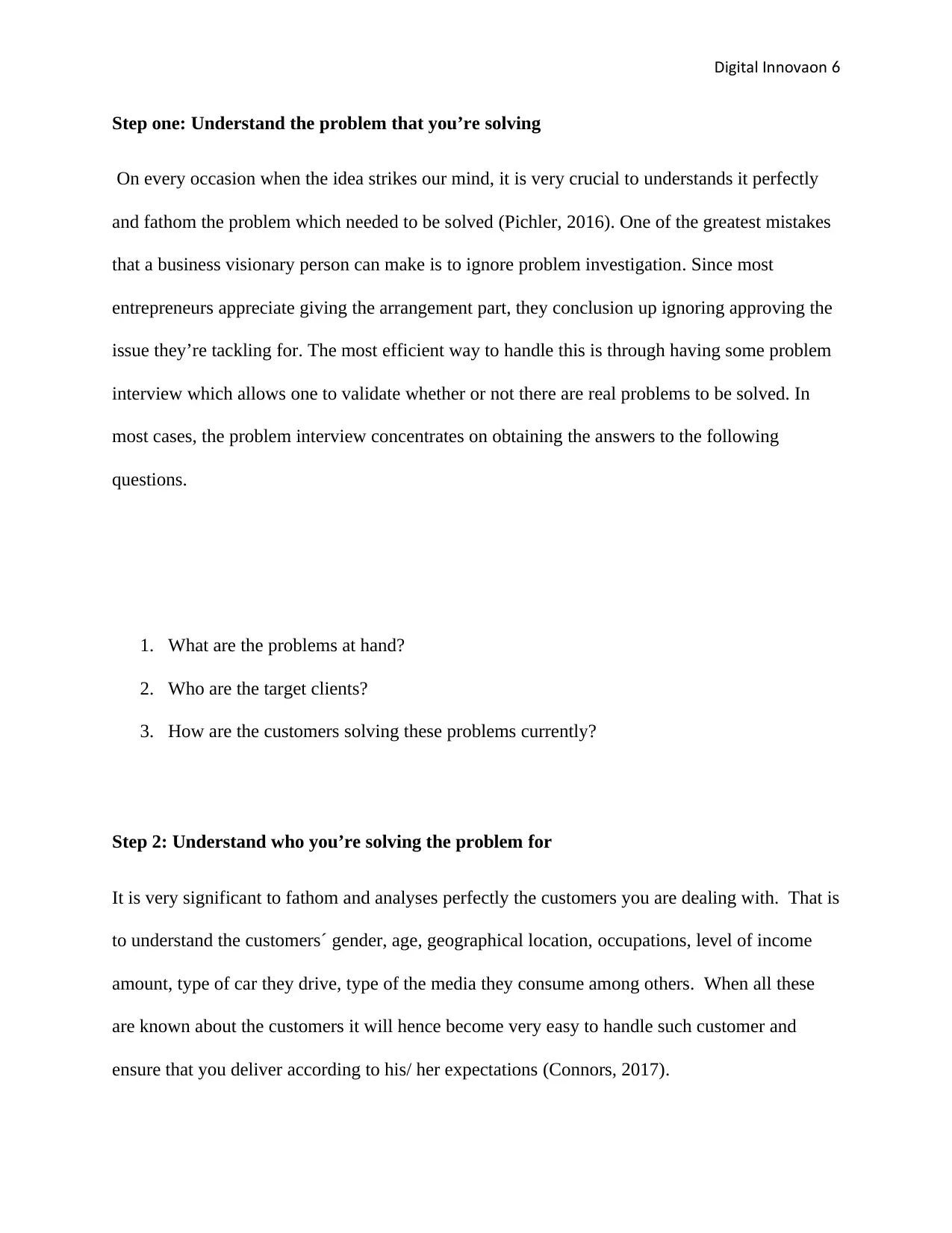
Digital nnovationI 6
Step one: Understand the problem that you’re solving
On every occasion when the idea strikes our mind, it is very crucial to understands it perfectly
and fathom the problem which needed to be solved (Pichler, 2016). One of the greatest mistakes
that a business visionary person can make is to ignore problem investigation. Since most
entrepreneurs appreciate giving the arrangement part, they conclusion up ignoring approving the
issue they’re tackling for. The most efficient way to handle this is through having some problem
interview which allows one to validate whether or not there are real problems to be solved. In
most cases, the problem interview concentrates on obtaining the answers to the following
questions.
1. What are the problems at hand?
2. Who are the target clients?
3. How are the customers solving these problems currently?
Step 2: Understand who you’re solving the problem for
It is very significant to fathom and analyses perfectly the customers you are dealing with. That is
to understand the customers´ gender, age, geographical location, occupations, level of income
amount, type of car they drive, type of the media they consume among others. When all these
are known about the customers it will hence become very easy to handle such customer and
ensure that you deliver according to his/ her expectations (Connors, 2017).
Step one: Understand the problem that you’re solving
On every occasion when the idea strikes our mind, it is very crucial to understands it perfectly
and fathom the problem which needed to be solved (Pichler, 2016). One of the greatest mistakes
that a business visionary person can make is to ignore problem investigation. Since most
entrepreneurs appreciate giving the arrangement part, they conclusion up ignoring approving the
issue they’re tackling for. The most efficient way to handle this is through having some problem
interview which allows one to validate whether or not there are real problems to be solved. In
most cases, the problem interview concentrates on obtaining the answers to the following
questions.
1. What are the problems at hand?
2. Who are the target clients?
3. How are the customers solving these problems currently?
Step 2: Understand who you’re solving the problem for
It is very significant to fathom and analyses perfectly the customers you are dealing with. That is
to understand the customers´ gender, age, geographical location, occupations, level of income
amount, type of car they drive, type of the media they consume among others. When all these
are known about the customers it will hence become very easy to handle such customer and
ensure that you deliver according to his/ her expectations (Connors, 2017).
⊘ This is a preview!⊘
Do you want full access?
Subscribe today to unlock all pages.

Trusted by 1+ million students worldwide
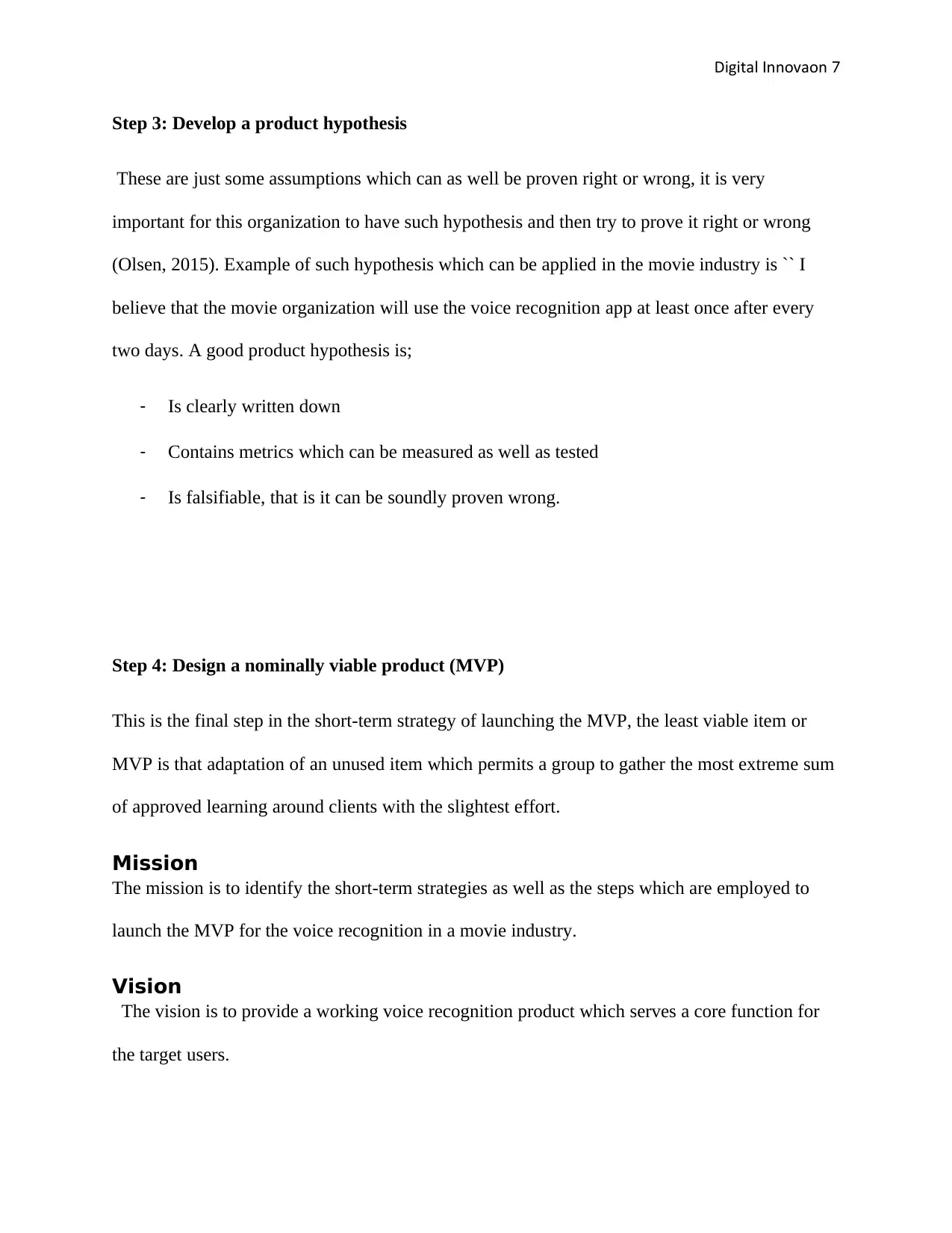
Digital nnovationI 7
Step 3: Develop a product hypothesis
These are just some assumptions which can as well be proven right or wrong, it is very
important for this organization to have such hypothesis and then try to prove it right or wrong
(Olsen, 2015). Example of such hypothesis which can be applied in the movie industry is `` I
believe that the movie organization will use the voice recognition app at least once after every
two days. A good product hypothesis is;
- Is clearly written down
- Contains metrics which can be measured as well as tested
- Is falsifiable, that is it can be soundly proven wrong.
Step 4: Design a nominally viable product (MVP)
This is the final step in the short-term strategy of launching the MVP, the least viable item or
MVP is that adaptation of an unused item which permits a group to gather the most extreme sum
of approved learning around clients with the slightest effort.
Mission
The mission is to identify the short-term strategies as well as the steps which are employed to
launch the MVP for the voice recognition in a movie industry.
Vision
The vision is to provide a working voice recognition product which serves a core function for
the target users.
Step 3: Develop a product hypothesis
These are just some assumptions which can as well be proven right or wrong, it is very
important for this organization to have such hypothesis and then try to prove it right or wrong
(Olsen, 2015). Example of such hypothesis which can be applied in the movie industry is `` I
believe that the movie organization will use the voice recognition app at least once after every
two days. A good product hypothesis is;
- Is clearly written down
- Contains metrics which can be measured as well as tested
- Is falsifiable, that is it can be soundly proven wrong.
Step 4: Design a nominally viable product (MVP)
This is the final step in the short-term strategy of launching the MVP, the least viable item or
MVP is that adaptation of an unused item which permits a group to gather the most extreme sum
of approved learning around clients with the slightest effort.
Mission
The mission is to identify the short-term strategies as well as the steps which are employed to
launch the MVP for the voice recognition in a movie industry.
Vision
The vision is to provide a working voice recognition product which serves a core function for
the target users.
Paraphrase This Document
Need a fresh take? Get an instant paraphrase of this document with our AI Paraphraser
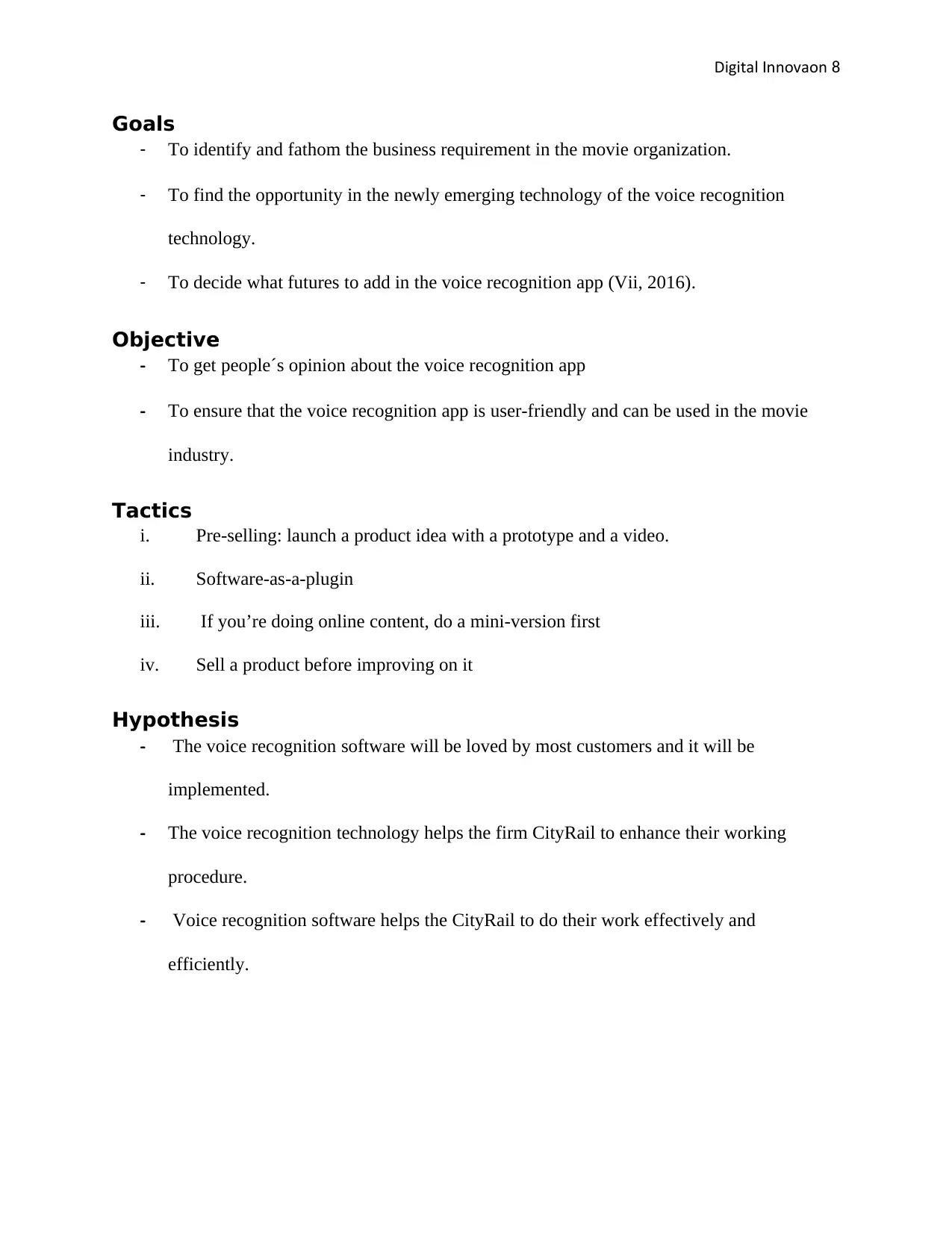
Digital nnovationI 8
Goals
- To identify and fathom the business requirement in the movie organization.
- To find the opportunity in the newly emerging technology of the voice recognition
technology.
- To decide what futures to add in the voice recognition app (Vii, 2016).
Objective
- To get people´s opinion about the voice recognition app
- To ensure that the voice recognition app is user-friendly and can be used in the movie
industry.
Tactics
i. Pre-selling: launch a product idea with a prototype and a video.
ii. Software-as-a-plugin
iii. If you’re doing online content, do a mini-version first
iv. Sell a product before improving on it
Hypothesis
- The voice recognition software will be loved by most customers and it will be
implemented.
- The voice recognition technology helps the firm CityRail to enhance their working
procedure.
- Voice recognition software helps the CityRail to do their work effectively and
efficiently.
Goals
- To identify and fathom the business requirement in the movie organization.
- To find the opportunity in the newly emerging technology of the voice recognition
technology.
- To decide what futures to add in the voice recognition app (Vii, 2016).
Objective
- To get people´s opinion about the voice recognition app
- To ensure that the voice recognition app is user-friendly and can be used in the movie
industry.
Tactics
i. Pre-selling: launch a product idea with a prototype and a video.
ii. Software-as-a-plugin
iii. If you’re doing online content, do a mini-version first
iv. Sell a product before improving on it
Hypothesis
- The voice recognition software will be loved by most customers and it will be
implemented.
- The voice recognition technology helps the firm CityRail to enhance their working
procedure.
- Voice recognition software helps the CityRail to do their work effectively and
efficiently.
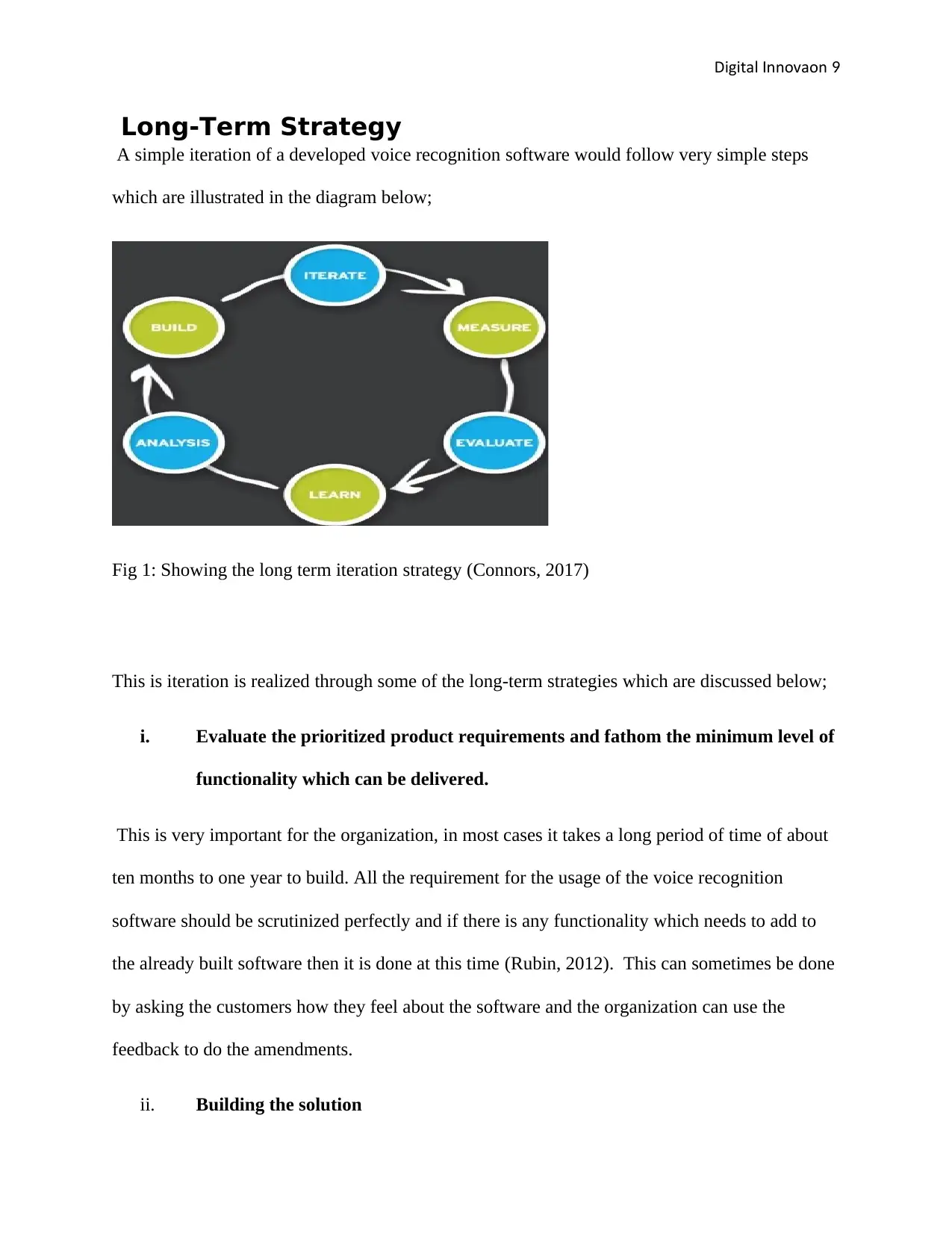
Digital nnovationI 9
Long-Term Strategy
A simple iteration of a developed voice recognition software would follow very simple steps
which are illustrated in the diagram below;
Fig 1: Showing the long term iteration strategy (Connors, 2017)
This is iteration is realized through some of the long-term strategies which are discussed below;
i. Evaluate the prioritized product requirements and fathom the minimum level of
functionality which can be delivered.
This is very important for the organization, in most cases it takes a long period of time of about
ten months to one year to build. All the requirement for the usage of the voice recognition
software should be scrutinized perfectly and if there is any functionality which needs to add to
the already built software then it is done at this time (Rubin, 2012). This can sometimes be done
by asking the customers how they feel about the software and the organization can use the
feedback to do the amendments.
ii. Building the solution
Long-Term Strategy
A simple iteration of a developed voice recognition software would follow very simple steps
which are illustrated in the diagram below;
Fig 1: Showing the long term iteration strategy (Connors, 2017)
This is iteration is realized through some of the long-term strategies which are discussed below;
i. Evaluate the prioritized product requirements and fathom the minimum level of
functionality which can be delivered.
This is very important for the organization, in most cases it takes a long period of time of about
ten months to one year to build. All the requirement for the usage of the voice recognition
software should be scrutinized perfectly and if there is any functionality which needs to add to
the already built software then it is done at this time (Rubin, 2012). This can sometimes be done
by asking the customers how they feel about the software and the organization can use the
feedback to do the amendments.
ii. Building the solution
⊘ This is a preview!⊘
Do you want full access?
Subscribe today to unlock all pages.

Trusted by 1+ million students worldwide
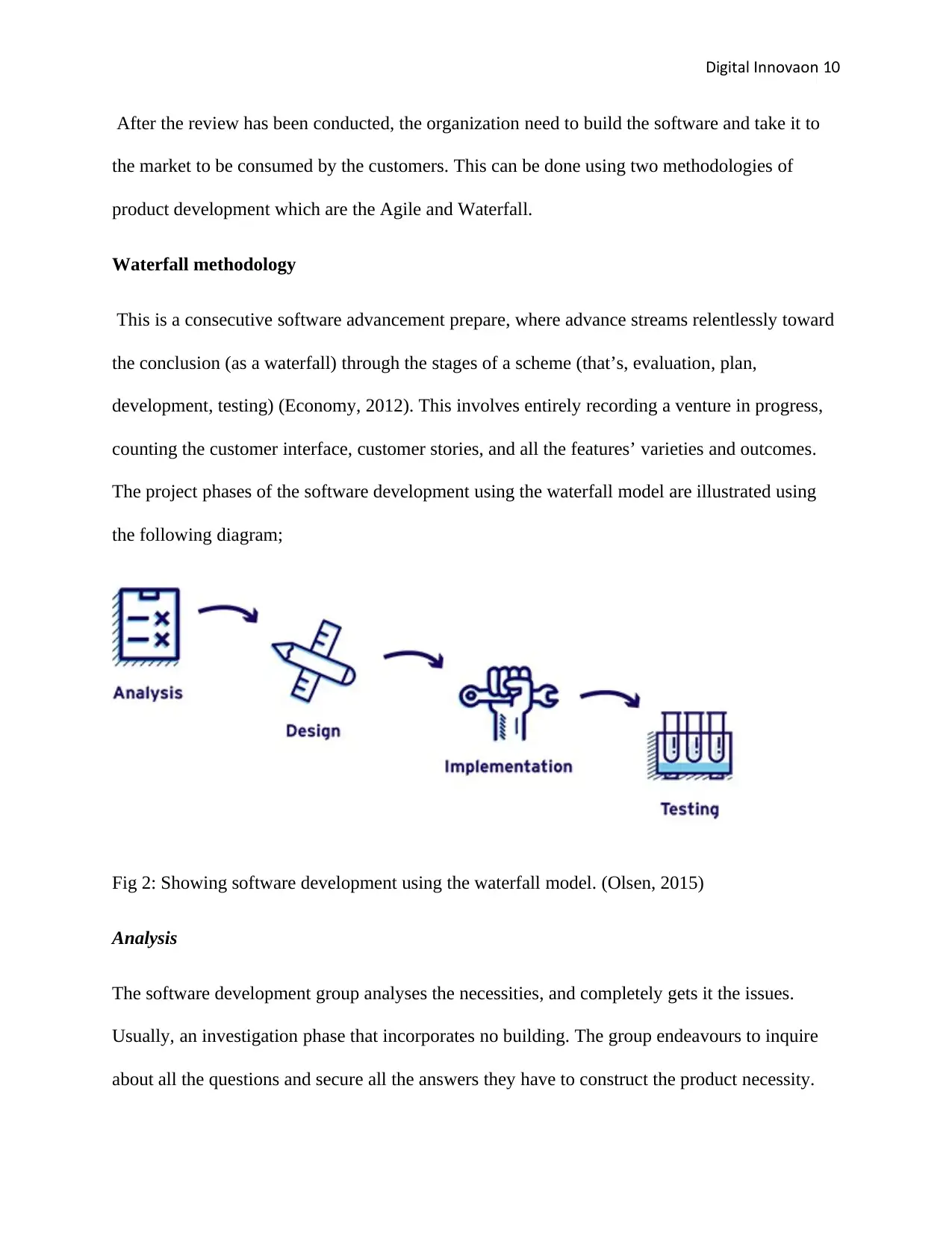
Digital nnovationI 10
After the review has been conducted, the organization need to build the software and take it to
the market to be consumed by the customers. This can be done using two methodologies of
product development which are the Agile and Waterfall.
Waterfall methodology
This is a consecutive software advancement prepare, where advance streams relentlessly toward
the conclusion (as a waterfall) through the stages of a scheme (that’s, evaluation, plan,
development, testing) (Economy, 2012). This involves entirely recording a venture in progress,
counting the customer interface, customer stories, and all the features’ varieties and outcomes.
The project phases of the software development using the waterfall model are illustrated using
the following diagram;
Fig 2: Showing software development using the waterfall model. (Olsen, 2015)
Analysis
The software development group analyses the necessities, and completely gets it the issues.
Usually, an investigation phase that incorporates no building. The group endeavours to inquire
about all the questions and secure all the answers they have to construct the product necessity.
After the review has been conducted, the organization need to build the software and take it to
the market to be consumed by the customers. This can be done using two methodologies of
product development which are the Agile and Waterfall.
Waterfall methodology
This is a consecutive software advancement prepare, where advance streams relentlessly toward
the conclusion (as a waterfall) through the stages of a scheme (that’s, evaluation, plan,
development, testing) (Economy, 2012). This involves entirely recording a venture in progress,
counting the customer interface, customer stories, and all the features’ varieties and outcomes.
The project phases of the software development using the waterfall model are illustrated using
the following diagram;
Fig 2: Showing software development using the waterfall model. (Olsen, 2015)
Analysis
The software development group analyses the necessities, and completely gets it the issues.
Usually, an investigation phase that incorporates no building. The group endeavours to inquire
about all the questions and secure all the answers they have to construct the product necessity.
Paraphrase This Document
Need a fresh take? Get an instant paraphrase of this document with our AI Paraphraser
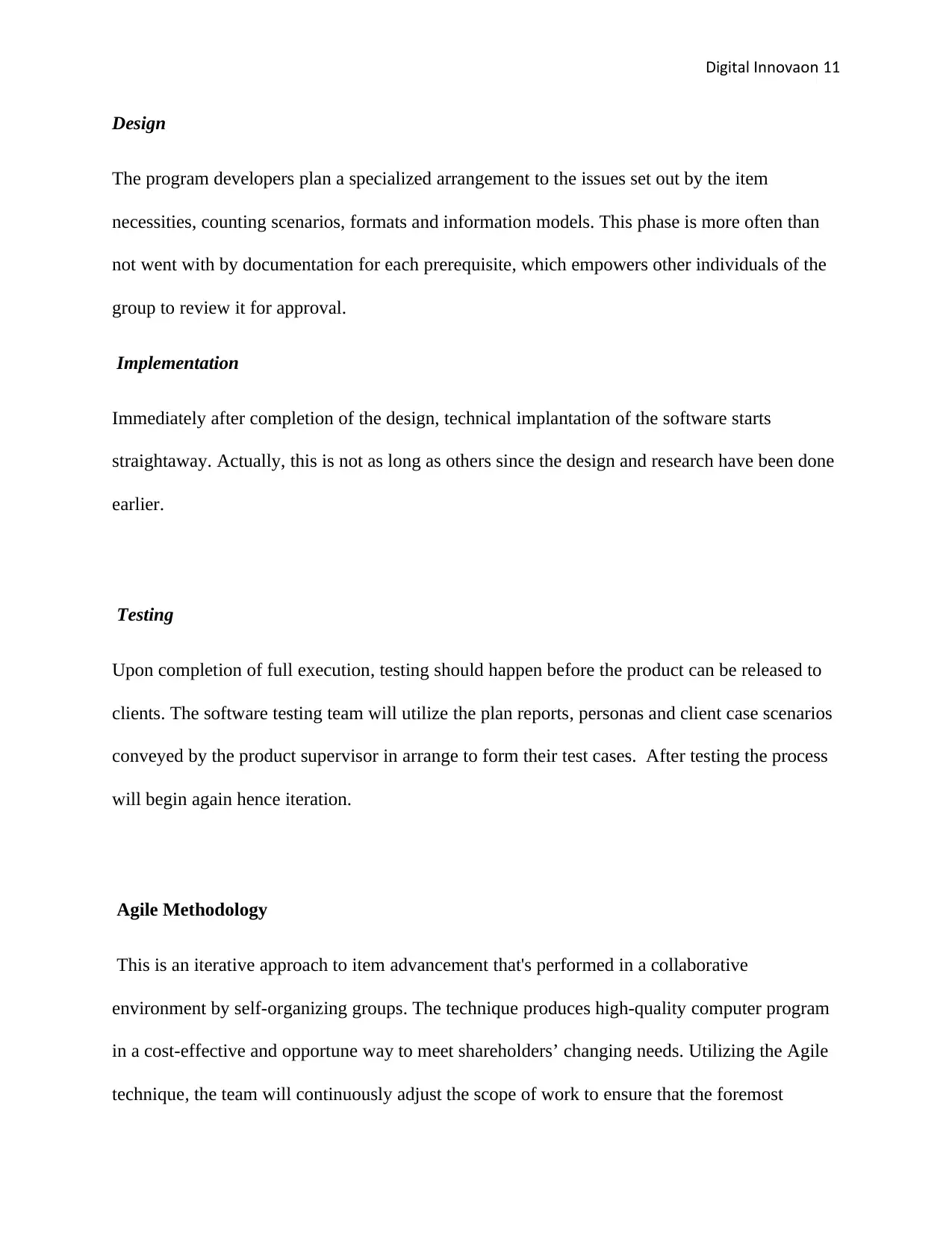
Digital nnovationI 11
Design
The program developers plan a specialized arrangement to the issues set out by the item
necessities, counting scenarios, formats and information models. This phase is more often than
not went with by documentation for each prerequisite, which empowers other individuals of the
group to review it for approval.
Implementation
Immediately after completion of the design, technical implantation of the software starts
straightaway. Actually, this is not as long as others since the design and research have been done
earlier.
Testing
Upon completion of full execution, testing should happen before the product can be released to
clients. The software testing team will utilize the plan reports, personas and client case scenarios
conveyed by the product supervisor in arrange to form their test cases. After testing the process
will begin again hence iteration.
Agile Methodology
This is an iterative approach to item advancement that's performed in a collaborative
environment by self-organizing groups. The technique produces high-quality computer program
in a cost-effective and opportune way to meet shareholders’ changing needs. Utilizing the Agile
technique, the team will continuously adjust the scope of work to ensure that the foremost
Design
The program developers plan a specialized arrangement to the issues set out by the item
necessities, counting scenarios, formats and information models. This phase is more often than
not went with by documentation for each prerequisite, which empowers other individuals of the
group to review it for approval.
Implementation
Immediately after completion of the design, technical implantation of the software starts
straightaway. Actually, this is not as long as others since the design and research have been done
earlier.
Testing
Upon completion of full execution, testing should happen before the product can be released to
clients. The software testing team will utilize the plan reports, personas and client case scenarios
conveyed by the product supervisor in arrange to form their test cases. After testing the process
will begin again hence iteration.
Agile Methodology
This is an iterative approach to item advancement that's performed in a collaborative
environment by self-organizing groups. The technique produces high-quality computer program
in a cost-effective and opportune way to meet shareholders’ changing needs. Utilizing the Agile
technique, the team will continuously adjust the scope of work to ensure that the foremost
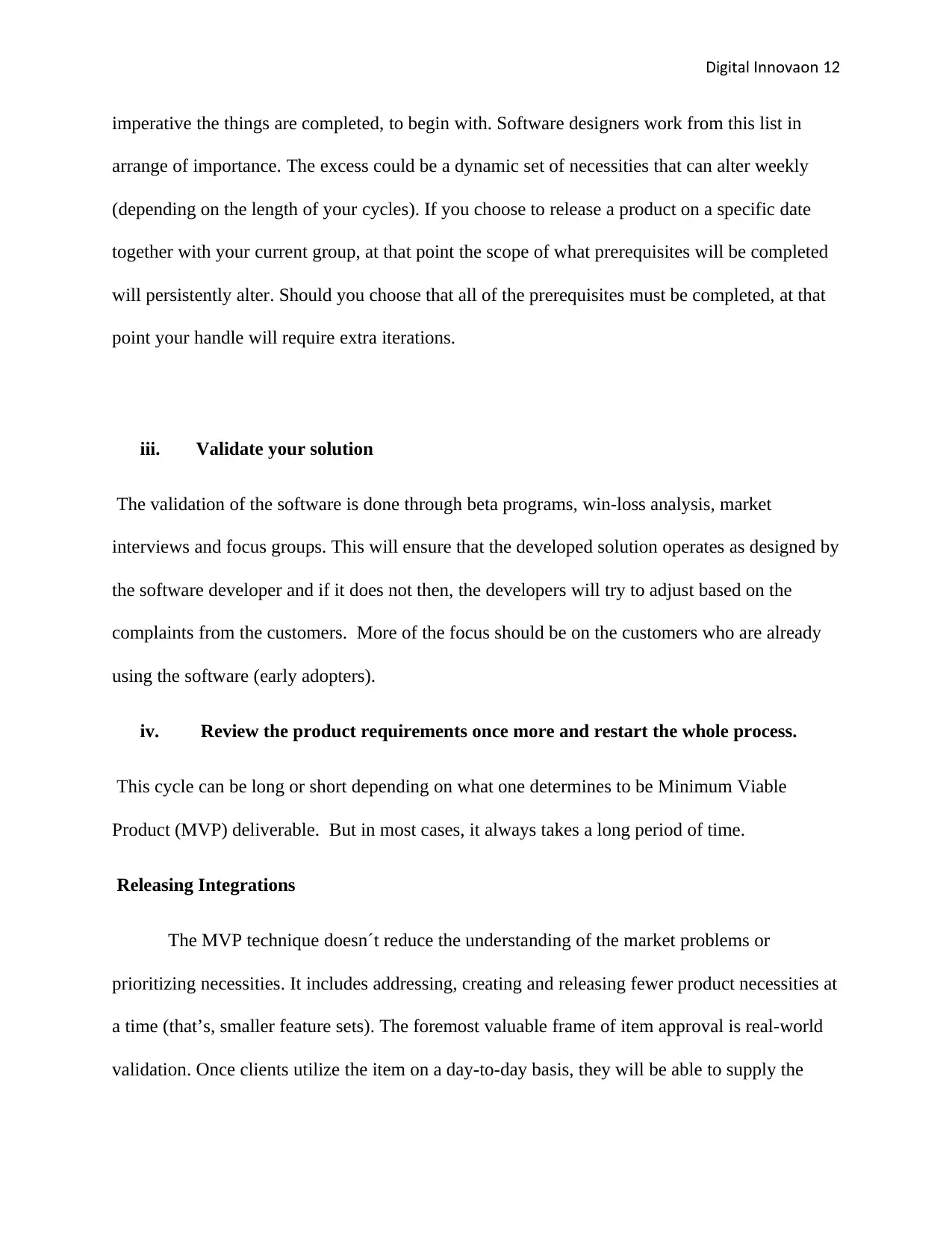
Digital nnovationI 12
imperative the things are completed, to begin with. Software designers work from this list in
arrange of importance. The excess could be a dynamic set of necessities that can alter weekly
(depending on the length of your cycles). If you choose to release a product on a specific date
together with your current group, at that point the scope of what prerequisites will be completed
will persistently alter. Should you choose that all of the prerequisites must be completed, at that
point your handle will require extra iterations.
iii. Validate your solution
The validation of the software is done through beta programs, win-loss analysis, market
interviews and focus groups. This will ensure that the developed solution operates as designed by
the software developer and if it does not then, the developers will try to adjust based on the
complaints from the customers. More of the focus should be on the customers who are already
using the software (early adopters).
iv. Review the product requirements once more and restart the whole process.
This cycle can be long or short depending on what one determines to be Minimum Viable
Product (MVP) deliverable. But in most cases, it always takes a long period of time.
Releasing Integrations
The MVP technique doesn´t reduce the understanding of the market problems or
prioritizing necessities. It includes addressing, creating and releasing fewer product necessities at
a time (that’s, smaller feature sets). The foremost valuable frame of item approval is real-world
validation. Once clients utilize the item on a day-to-day basis, they will be able to supply the
imperative the things are completed, to begin with. Software designers work from this list in
arrange of importance. The excess could be a dynamic set of necessities that can alter weekly
(depending on the length of your cycles). If you choose to release a product on a specific date
together with your current group, at that point the scope of what prerequisites will be completed
will persistently alter. Should you choose that all of the prerequisites must be completed, at that
point your handle will require extra iterations.
iii. Validate your solution
The validation of the software is done through beta programs, win-loss analysis, market
interviews and focus groups. This will ensure that the developed solution operates as designed by
the software developer and if it does not then, the developers will try to adjust based on the
complaints from the customers. More of the focus should be on the customers who are already
using the software (early adopters).
iv. Review the product requirements once more and restart the whole process.
This cycle can be long or short depending on what one determines to be Minimum Viable
Product (MVP) deliverable. But in most cases, it always takes a long period of time.
Releasing Integrations
The MVP technique doesn´t reduce the understanding of the market problems or
prioritizing necessities. It includes addressing, creating and releasing fewer product necessities at
a time (that’s, smaller feature sets). The foremost valuable frame of item approval is real-world
validation. Once clients utilize the item on a day-to-day basis, they will be able to supply the
⊘ This is a preview!⊘
Do you want full access?
Subscribe today to unlock all pages.

Trusted by 1+ million students worldwide
1 out of 22
Related Documents
Your All-in-One AI-Powered Toolkit for Academic Success.
+13062052269
info@desklib.com
Available 24*7 on WhatsApp / Email
![[object Object]](/_next/static/media/star-bottom.7253800d.svg)
Unlock your academic potential
Copyright © 2020–2025 A2Z Services. All Rights Reserved. Developed and managed by ZUCOL.





